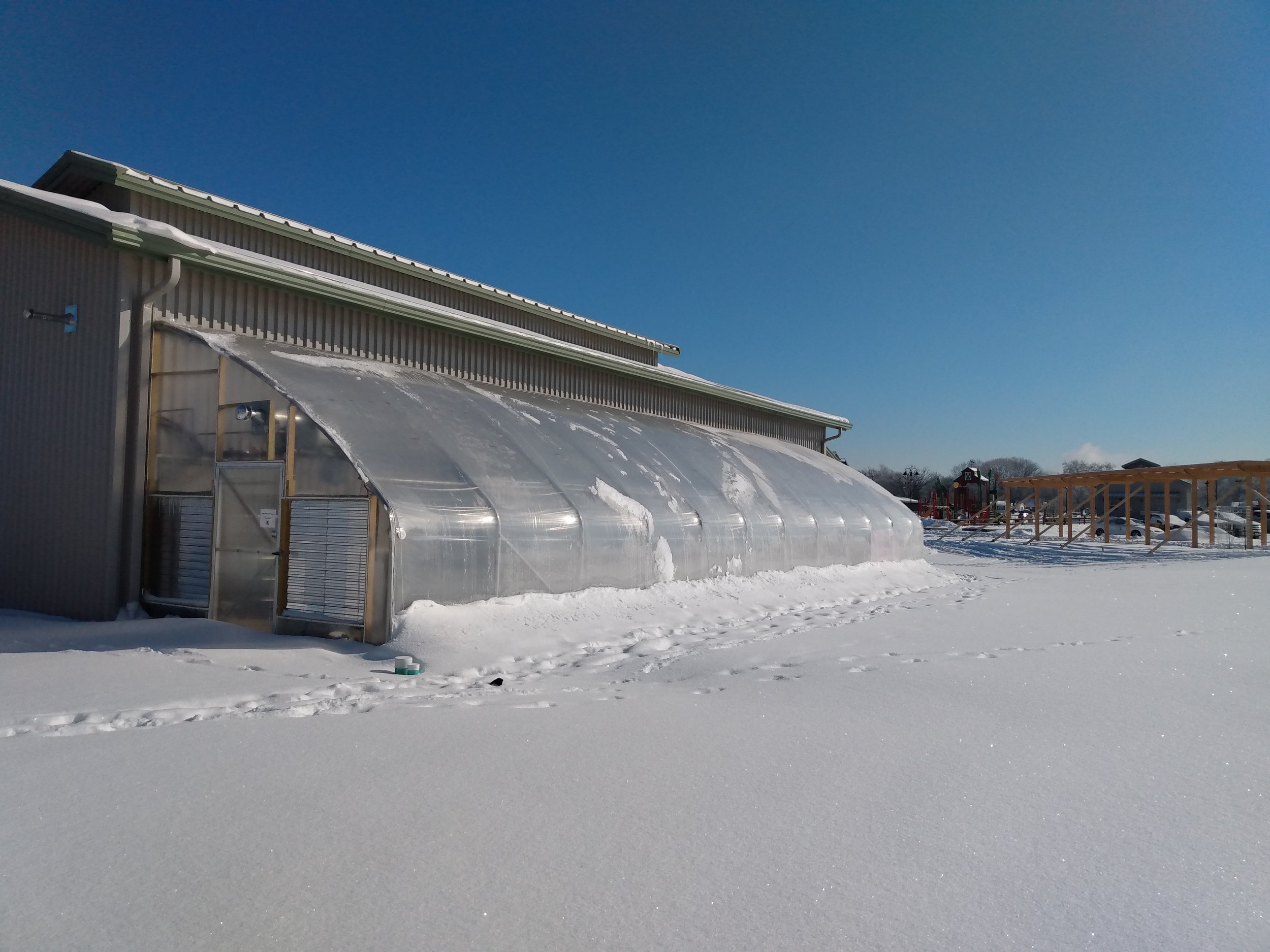Columbia's Agriculture Park
Columbia’s Agriculture Park is a ten acre space housed in the Clary-Shy Community Park on West Ash Street, Columbia, Missouri. Just 1.5 miles from the Food Bank Market, it is home to CCUA’s main Planting for the Pantry production fields as well as public garden and programming spaces that showcase a variety of food-farming techniques and urban ecosystems. Sidewalks loop around the park and meet winding, gravel pathways that will lead you to explore our food forest and backyard demonstration garden spaces. The park is open year-round to the public to visit and enjoy.
Each season, scheduled volunteers and organizations donate thousands of hours to work and learn alongside CCUA staff as we develop the park for the community to enjoy, while also providing fresh, local produce for local hunger relief.
Learn more about CCUA’s spaces at the Agriculture Park: Production fields, Backyard demonstration garden spaces, Food forest, Schoolhouse and youth garden space, Native habitat gardens and water retention basin, Greenhouse
Other spaces at the Agriculture Park: Columbia Farmers Market, ARC
CCUA spaces at the park
Production Fields
The Planting for the Pantry program farms one acre of Columbia’s Agriculture Park specifically for local hunger relief. Each year’s crop plan is created based on annual feedback from the Food Bank Market and community members who shop at the market, and seeks to provide a wide variety of fresh fruits and vegetables throughout the growing season.
Planting for the Pantry’s Production Fields at Columbia’s Agriculture Park emphasize:
intensive urban farming and a range of small-farm/large-garden production practices that don’t require heavy machinery,
good soil stewardship, and strategies for regenerating biological life and productivity in our clay-dominated mid-Missouri soils,
biodiversity-enhancing farm practices that reclaim compacted fields of bermuda grass naturally.
This program offers a space for community members to develop greater skills in growing food and to participate within a broader part of the food system.
Backyard Demonstration Gardens
The backyard demonstration garden showcases different ways to grow food at a size and scale that’ll fit in a typical Columbia backyard, and sometimes even on a doorstep or patio. This space demonstrates fruit tree varieties that grow well in central Missouri, how to use in-ground beds and raised beds for vegetable production, various composting methods, and approaches for watering with and without a water hook-up.
The demonstration garden is also home to our bright red chicken coop! Featuring windows at both child and adult height, we invite park goers to take a peek inside the coop as well as ask our staff the how-tos of owning backyard chickens in Columbia!
Curved gravel pathways allow visitors and field trips access to get up close and become inspired by all kinds of ways you can farm a backyard.
Food Forest
One part forest and one part fruit orchard, the Food Forest is an area of Columbia’s Agriculture Park with 40+ individual fruit and nut trees that grow well in our mid-Missouri climate. Similar to the understory of a forest, beneath and around the fruit trees are different perennial shrubs, berry brambles, and herbs, all of which provide us sources of food from forest floor to canopy.
Wander the gravel pathway to find apple, cherry, peach, apricot, pear, plum, and pecan trees, plus possibly some less-familiar fruits such as che (Chinese Mulberry), jujubes, Asian persimmons, and medlars.
Schoolhouse and Youth Garden Space
The Schoolhouse is our Youth Education team’s home base when they aren’t off-site in local school gardens or area organizations’ teaching spaces. Raised bed gardens showcase kid-approved fruits and veggies used in tastings and other programming, while the schoolhouse offers lessons to complement tours and activities on the farm.
Visit the garden space often throughout the season to discover fun new features!
Learn more about renting the schoolhouse for your next event!
Native Habitat Gardens & Water Retention Basin
The north-west corner of Columbia’s Agriculture Park is naturally the park’s low point, and a visit in any good rainstorm will demonstrate how it’s where the water from the park wants to be. The retention basin is designed to slow the flow of stormwater and hold on to it while also providing important habitat for beneficial insects and wildlife at the park.
Rainwater from above, stormwater running through underground piping, and the rinse water used for washing produce for the pantry all route to the retention basin where it then snakes through twists and turns made of native wetland plants, soil/rock berms, and pools lined with retaining-wall bricks. During this journey the water is slowed down, absorbed by the plants and surrounding soil, and given time to evaporate before it makes it to the weir and ultimately creek on the north of the sidewalk — it’s a natural obstacle course for water that reduces flooding in strong rainstorms.
The plants used in the retention basin focus on native trees and shrubs — such as elderberries, hazelnuts, serviceberries, paw paws, American persimmons, and black chokeberry (Aronia berry) — that produce edible fruits for humans, and flowering plants whose leaves and nectar feed bees and other insects.
Blackberry Trellises
The blackberry trellis is designed to demonstrate a permanent system that will withstand outdoor conditions for many years, hold the weight of mature blackberry canes, and provide pedestrians with an easy access point for harvests. Varieties — Natchez, Caddo, Triple Crown, Chester, Caroline — were chosen to ripen at different points of the summer, to stretch out blackberry season. Because blackberries fruit on the previous year’s growth, this trellis structure also helps alternate pruning to keep one full side in fruit mode while the alternating side puts on new growth.
Greenhouse
The greenhouse at Columbia’s Agriculture Park is used from early February through late summer to start transplants for the Planting for the Pantry, Opportunity Gardens, and Youth Education programs of CCUA. Trays of seedlings sit on heat mats or special tables lined with tubing that circulate hot water below the plants, keeping the soil at the optimum temperature.
Greenhouse seeding uses the technique of soil blocking to press trays full of soil blocks — little moist cubes of soil — in which seeds can be planted. Each seedling gets its own block to grow in until the whole block and seedling is transplanted into a garden bed. The whole process from seeding to transplanting never uses a single pot.
Also at Columbia’s Agriculture Park
Columbia Farmers Market
Columbia’s Agriculture Park is also home to Columbia Farmers Market. Open year-round and showcasing nothing but products made directly by farmers within a 50 mile radius of Columbia, the farmers market has operated in some form at this site since the 1980s. Visit Columbia Farmers Market’s website for more information on hours, vendors, and programs, and more.
Activity & Recreation Center
The ARC is a health club and fitness center featuring an indoor leisure pool, gymnasium (including basketball, volleyball, and pickleball), strength training equipment and weights, cardio equipment, indoor track, group exercise classes, and more. Learn more about the ARC from the City of Columbia’s website.









